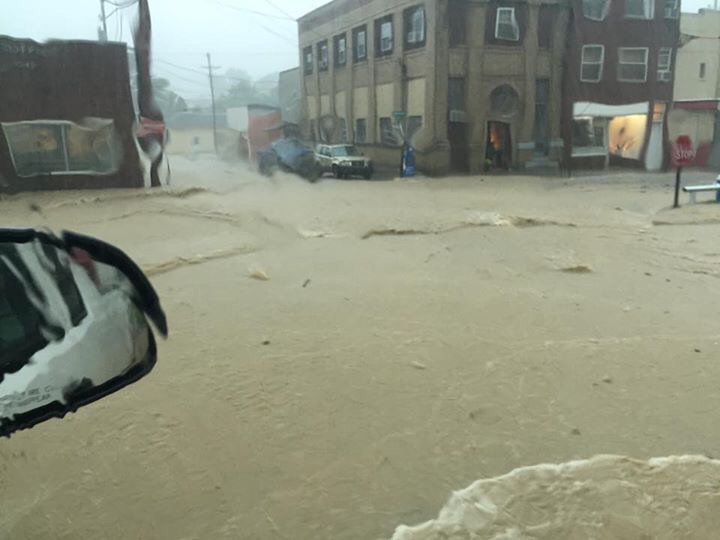As a result of human caused global warming, the atmospheric and the oceans (and lakes, rivers and streams) are warmer.....warmer air can hold more water vapor......warmer oceans and other bodies of water tend to evaporate more water faster.....and now, water vapor levels have increased so much, rain and snowstorms can drop much larger quantities of water than before the air warmed and water vapor levels increased.
Although the denier cultists will undoubtedly chant that there have always been heavy rain and floods and massive blizzards, the plain fact is that all of those are becoming more intense and destructive because of the greater amount of water held in the air......which results in this example of global warming driven climate disruptions in action:
"...the torrential flooding after as much as 8-10 inches of rain fell in six to eight hours in parts of the state on Thursday", according to the National Weather Service. This amount of rain in such a short time is likely a "one-in-a-thousand-year event," the weather service said.
At least 26 dead as historic floods sweep West Virginia
USA TODAY
Doug Stanglin and Doyle Rice,
June 25, 2016
(excerpts)
The bodies of three more victims of West Virginia's historic flooding were found overnight Saturday, according to county authorities, raising the death toll to 26 from torrential rains and high water that has destroyed more than 100 homes, washed out scores of roads and bridges and knocked out power to tens of thousands of people. On Saturday, President Obama declared a major disaster for West Virginia and ordered federal aid to supplement state and local recovery efforts in the counties of Greenbrier, Kanawha and Nicholas.
...At least 23 others, including an 8-year-old boy who was wading in a foot of water, were killed in the torrential flooding after as much as 8-10 inches of rain fell in six to eight hours in parts of the state on Thursday, according to the National Weather Service. This amount of rain in such a short time is likely a "one-in-a-thousand-year event," the weather service said. The heavy rains and rising water swamped towns, inundated a two-century old resort and trapped 500 people in a shopping center when a bridge was washed out. The storm also knocked out power to 66,000 West Virginians, and forced the shut off of gas in the town of White Sulphur Springs, Tomblin said.
Gov. Earl Ray Tomblin told reporters Friday that damage is widespread and devastating. Saying search and rescue missions are still a top priority, Tomblin issued a state of emergency for 44 counties and deployed 150 members of the National Guard to help emergency responders. The Governer said 60 roads were closed, many of them destroyed, bridges were knocked out, and homes were burned down and washed off foundations. Tens of thousands of people were without power, and several roads were impassable, the Associated Press reported. One dramatic video posted on the WVMetro news website showed a burning house floating down Howard's Creek in White Sulphur Springs.
FLOOD EMERGENCY: Clendenin,WV can only be accessed by helicopter.
As a result of human caused global warming, the atmospheric and the oceans (and lakes, rivers and streams) are warmer
How much warmer?
How do you know?
NASA Earth Science News Team
Beaufort Sea surface temperatures where Canada's Mackenzie River discharges into the Arctic Ocean, measured by NASA's MODIS instrument. The top image is from June 14, 2012. In the bottom image (July 5, 2012), warm river waters had broken through a shoreline sea ice barrier to enhance sea ice melt.
Image Credit: NASA
The heat from warm river waters draining into the Arctic Ocean is contributing to the melting of Arctic sea ice each summer, a new NASA study finds.
A research team led by Son Nghiem of NASA’s Jet Propulsion Laboratory in Pasadena, Calif., used satellite data to measure the surface temperature of the waters discharging from a Canadian river into the icy Beaufort Sea during the summer of 2012. They observed a sudden influx of warm river waters into the sea that rapidly warmed the surface layers of the ocean, enhancing the melting of sea ice. A paper describing the study is now published online in the journal Geophysical Research Letters.

NASA MODIS movie from June 14, 2012, shows a blue band of sea ice stuck to the Mackenzie River shoreline. The map fades, revealing the seafloor depth below. The band of stuck sea ice closely follows the highlighted 25-meter-depth contour line. The seafloor topography helps delay river discharge. Image Credit: NASA/International Bathymetric Chart of the Arctic Ocean
See animation
This Arctic process contrasts starkly with those that occur in Antarctica, a frozen continent without any large rivers. The sea ice cover in the Southern Ocean surrounding Antarctica has been relatively stable, while Arctic sea ice has been declining rapidly over the past decade.
“River discharge is a key factor contributing to the high sensitivity of Arctic sea ice to climate change,” said Nghiem. “We found that rivers are effective conveyers of heat across immense watersheds in the Northern Hemisphere. These watersheds undergo continental warming in summertime, unleashing an enormous amount of energy into the Arctic Ocean, and enhancing sea ice melt. You don’t have this in Antarctica.”
The team said the impacts of these warm river waters are increasing due to three factors. First, the overall volume of water discharged from rivers into the Arctic Ocean has increased. Second, rivers are getting warmer as their watersheds (drainage basins) heat up. And third, Arctic sea ice cover is becoming thinner and more fragmented, making it more vulnerable to rapid melt. In addition, as river heating contributes to earlier and greater loss of the Arctic’s reflective sea ice cover in summer, the amount of solar heat absorbed into the ocean increases, causing even more sea ice to melt.
Climate Change: Vital Signs of the Planet: Warm rivers play role in Arctic sea ice melt
Do you want more?








